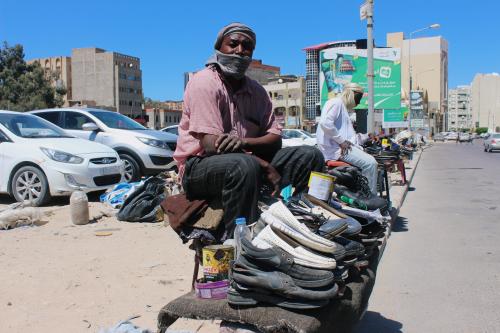Editor’s note: Megan Bradley discusses the new study, Supporting Durable Solutions to Urban, Post-Disaster Displacement: Challenges and Opportunities in Haiti, that examines the question of durable solutions to displacement in Port-au-Prince, recognizing that the challenges faced in Haiti may be a source of insight for responses to other urban, post-disaster displacement crises – which are expected to become more common in the future.
Four months ago, Typhoon Haiyan – also known as Yolanda – ripped through the Philippines. An estimated 4 million people – more than the entire population of the city of Los Angeles – were forced from their homes. The challenge of resolving this displacement crisis still looms large.
Four years ago, Haiti was also confronted by a massive displacement crisis caused by a devastating natural disaster – the January 2010 earthquake that damaged or destroyed over 293,000 homes, and prompted 1.5 million Haitians to seek shelter in 1,500 camps spread across Port-au-Prince and the surrounding area. What insights do experiences in Haiti hold for the Philippines and other countries struggling to support durable solutions for the thousands if not millions of people who are uprooted every year by natural disasters?
A recent study from the Brookings-LSE Project on Internal Displacement and the International Organization for Migration (IOM) examines this question, and the obstacles to the sustainable resolution of displacement in Port-au-Prince. All but 147,000 of Haiti’s internally displaced persons (IDPs) have now left the camps that were established after the earthquake, the majority of which have now closed. Yet, the results of our survey of 2,500 households living outside of camps in Port-au-Prince show that the sustainable resolution of displacement in Haiti remains an unmet challenge.
Poor Haitians – displaced and non-displaced alike – are confronted by many serious and similar problems, including lack of access to schools, health care and jobs. But the experience of displacement has made a hard situation worse for many residents of Port-au-Prince: almost 61 percent of displaced families indicate that their overall living conditions have declined since the disaster, compared to 38.9 percent of non-displaced households. Families who were displaced by the earthquake were twice as likely to experience a decline in their housing situation, and continue to face significantly reduced access to water, latrines and health care. Use the study’s interactive tool to examine further results from the survey.
The report maps out recommendations for addressing the challenges that displacement continues to pose in Port-au-Prince. But what are the implications of the Haitian experience for other cases? Each disaster is different, and requires an appropriately tailored approach. Yet as governments, international organizations and NGOs work to support solutions to displacement crises caused by natural disasters in countries from the Philippines to Pakistan, the following lessons gleaned from experiences in Haiti may strengthen their efforts:
• Raise awareness of international standards
International standards such as the 2010 Inter-Agency Standing Committee (IASC) Framework on Durable Solutions for Internally Displaced Persons provide essential insight into the concept of durable solutions, and the process of supporting the sustainable resolution of displacement after conflicts and disasters. Yet many humanitarian and development actors working in post-disaster displacement situations do not know about this critical tool. Increased efforts are needed to raise awareness of the IASC Framework, and how it may be effectively applied, particularly in post-disaster settings.
• Recognize that displacement is also a development issue
Displacement is often seen as a problem for humanitarian actors to deal with, but effectively supporting durable solutions depends on the recognition that displacement is also a development issue. Displacement crises are often rooted in development failures, and can only be resolved through long-term development support that puts the rights and wellbeing of the poorest sectors of society front and center.
• Develop and implement disaster response strategies early on
Strategies to support durable solutions for the internally displaced need to be developed and implemented from the early stages of disaster response. While attention is often focused on IDPs living in camps, such strategies must also take into consideration the needs of IDPs living outside of camps, and the families and communities that are hosting them. Particularly when disasters strike cities, durable solutions strategies need to be attuned to factors such as the rental market and urban-rural dynamics.
• Advocate for human rights protection
Whether in post-conflict or post-disaster situations, human rights protection is central to the durable resolution of displacement. In urban, post-disaster contexts, unlawful evictions represent a particularly significant obstacle to the durable resolution of displacement requiring concerted attention and advocacy.
• Take the lead from the displaced
The sustainable resolution of displacement is a long-term undertaking – but one that it is in states’ own interest to address promptly and comprehensively. Otherwise, disasters can undercut both national development gains, and the wellbeing of families already struggling to get by. Whether in Haiti, the Philippines or elsewhere, it is invariably displaced families themselves who are at the forefront of this struggle. As much as possible, governments, donors and aid organization should take the lead from the displaced, supporting the solutions they envision as they recover from disaster.


Commentary
Resolving Displacement After Disasters: Insights From Haiti
March 14, 2014